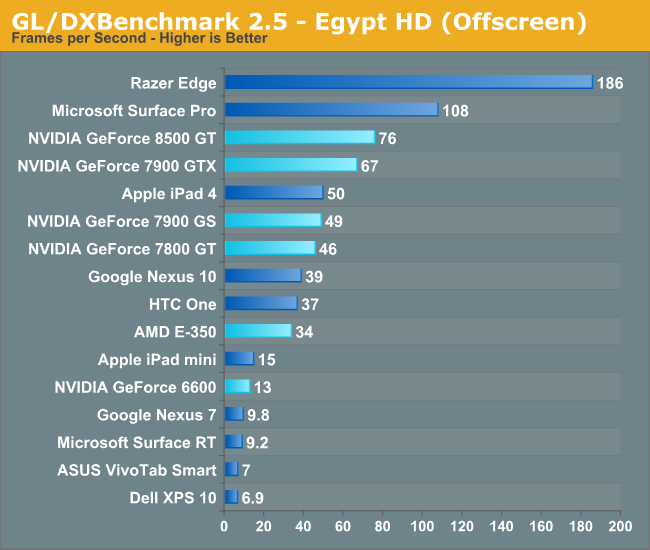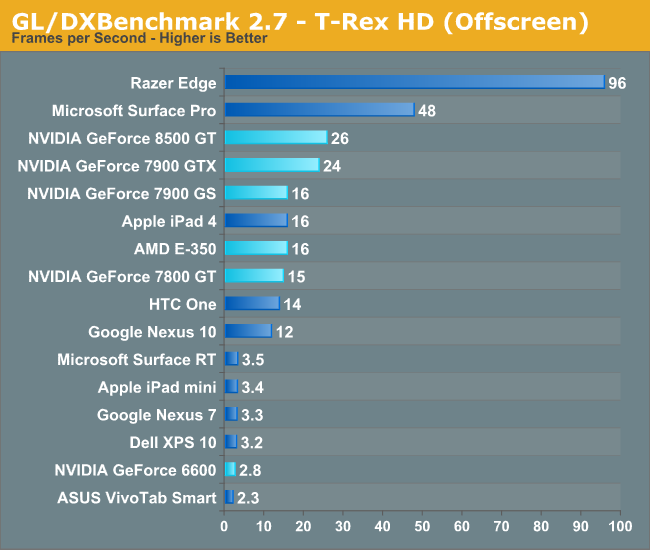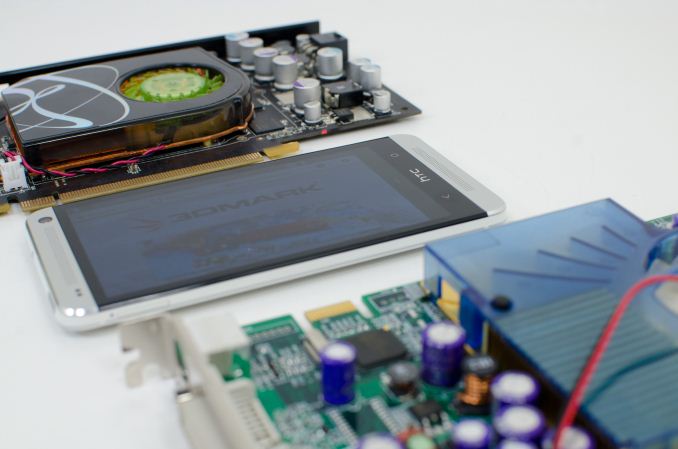The Great Equalizer 3: How Fast is Your Smartphone/Tablet in PC GPU Terms
by Anand Lal Shimpi on April 4, 2013 1:00 AM EST- Posted in
- Tablets
- Smartphones
- Mobile
- GPUs
- SoCs
GL/DXBenchmark 2.7 & Final Words
While the 3DMark tests were all run at 720p, the GL/DXBenchmark results run at roughly 2.25x the pixel count: 1080p. We get a mixture of low level and simulated game benchmarks with GL/DXBenchmark 2.7, the former isn't something 3DMark offers across all platforms today. The game simulation tests are far more strenuous here, which should do a better job of putting all of this in perspective. The other benefit we get from moving to Kishonti's test is the ability to compare to iOS and Windows RT as well. There will be a 3DMark release for both of those platforms this quarter, we just don't have final software yet.
We'll start with the low level tests, beginning with Kishonti's fill rate benchmark:

Looking at raw pixel pushing power, everything post Apple's A5 seems to have displaced NVIDIA's GeForce 6600. NVIDIA's Tegra 3 doesn't appear to be quite up to snuff with the NV4x class of hardware here, despite similarities in the architectures. Both ARM's Mali-T604 (Nexus 10) and ImgTec's PowerVR SGX 554MP4 (iPad 4) do extremely well here. Both deliver higher fill rate than AMD's Radeon HD 6310, and in the case of the iPad 4 are capable to delivering midrange desktop GPU class performance from 2004 - 2005.
Next we'll look at raw triangle throughput. The vertex shader bound test from 3DMark did some funny stuff to the old G7x based architectures, but GL/DXBenchmark 2.7 seems to be a bit kinder:

Here the 8500 GT definitely benefits from its unified architecture as it is able to direct all of its compute resources towards the task at hand, giving it better performance than the 7900 GTX. The G7x and NV4x based architectures unfortunately have limited vertex shader hardware, and suffer as a result. That being said, most of the higher end G7x parts are a bit too much for the current crop of ultra mobile GPUs. The midrange NV4x hardware however isn't. The GeForce 6600 manages to deliver triangle throughput just south of the two Tegra 3 based devices (Surface RT, Nexus 7).
Apple's iPad 4 even delivers better performance here than the Radeon HD 6310 (E-350).
ARM's Mali-T604 doesn't do very well in this test, but none of ARM's Mali architectures have been particularly impressive in the triangle throughput tests.
With the low level tests out of the way, it's time to look at the two game scenes. We'll start with the less complex of the two, Egypt HD:

Now we have what we've been looking for. The iPad 4 is able to deliver similar performance to the GeForce 7900 GS, and 7800 GT, which by extension means it should be able to outperform a 6800 Ultra in this test. The vanilla GeForce 6600 remains faster than NVIDIA's Tegra 3, which is a bit disappointing for that part. The good news is Tegra 4 should be somewhere around high-end NV4x/upper-mid-range G7x performance in this sort of workload. Again we're seeing Intel's HD 4000 do remarkably well here. I do have to caution anyone looking to extrapolate game performance from these charts. At best we know how well these GPUs stack up in these benchmarks, until we get true cross-platform games we can't really be sure of anything.
For our last trick, we'll turn to the insanely heavy T-Rex HD benchmark. This test is supposed to tide the mobile market over until the next wave of OpenGL ES 3.0 based GPUs take over, at which point GL/DXBenchmark 3.0 will step in and keep everyone's ego in check.

T-Rex HD puts the iPad 4 (PowerVR SGX 554MP4) squarely in the class of the 7800 GT and 7900 GS. Note the similarity in performance between the 7800 GT and 7900 GS indicates the relatively independent nature of T-Rex HD when it comes to absurd amounts of memory bandwidth (relatively speaking). Given that all of the ARM platforms south of the iPad 4 line have less than 12.8GB/s of memory bandwidth (and those are the platforms these benchmarks were designed for), a lack of appreciation for the 256-bit memory interfaces on some of the discrete cards is understandable. Here the 7900 GTX shows a 50% increase in performance over the 7900 GS. Given the 62.5% advantage the GTX holds in raw pixel shader performance, the advantage makes sense.
The 8500 GT's leading performance here is likely due to a combination of factors. Newer drivers, a unified shader architecture that lines up better with what the benchmark is optimized to run on, etc... It's still remarkable how well the iPad 4's A6X SoC does here as well as Qualcomm's Snapdragon 600/Adreno 320. The latter is even more impressive given that it's constrained to the power envelope of a large smartphone and not a tablet. The fact that we're this close with such portable hardware is seriously amazing.
At the end of the day I'd say it's safe to assume the current crop of high-end ultra mobile devices can deliver GPU performance similar to that of mid to high-end GPUs from 2006. The caveat there is that we have to be talking about performance in workloads that don't have the same memory bandwidth demands as the games from that same era. While compute power has definitely kept up (as has memory capacity), memory bandwidth is no where near as good as it was on even low end to mainstream cards from that time period. For these ultra mobile devices to really shine as gaming devices, it will take a combination of further increasing compute as well as significantly enhancing memory bandwidth. Apple (and now companies like Samsung as well) has been steadily increasing memory bandwidth on its mobile SoCs for the past few generations, but it will need to do more. I suspect the mobile SoC vendors will take a page from the console folks and/or Intel and begin looking at embedded/stacked DRAM options over the coming years to address this problem.











128 Comments
View All Comments
IntelUser2000 - Thursday, April 4, 2013 - link
@zlim:It would be lot closer, because the HD 4000 in the regular variant is only 50-60% faster than the HD 3000. The HD 4000 in ULV is maybe only 30-40% faster.
zeo - Tuesday, April 16, 2013 - link
Mind though that the iPad is using a quad GPU, while the Intel GMA's are single GPUs... Also this isn't counting discrete graphic cards, which scale much higher than Integrate GPU's can go. Even AMD's best APU still barely provides what would be a mid-range discrete graphic card performance.ltcommanderdata - Thursday, April 4, 2013 - link
These results seem to suggest that high-end mobile GPUs are very close to current-gen consoles (nVidia 7900 class) and that the HD4000 is faster than current-gen consoles. Based on realizable graphics in games it doesn't seem that close although that may be advantages in bandwidth and close-to-metal access showing through."Again, the new 3DMark appears to unfairly penalize the older non-unified NVIDIA GPU architectures. Keep in mind that the last NVIDIA driver drop for DX9 hardware (G7x and NV4x) was last October, before either benchmark had been released. The 8500 GT on the other hand gets the benefit of a driver released this month."
You mentioned you were using nVidia drivers from October 2012, but the latest legacy drivers for the 6000/7000 series is GeForce 307.83 from February 2013 for Windows 7 and GeForce 307.74 from January 2013 for Windows 8.
perry1mm - Thursday, April 4, 2013 - link
This will be speaking in terms of mobile graphics for the HD 4000:Combined with the proper specs (fast RAM, higher clocked processor frequencies without the TDP holding it back from turbo-boosting, and a higher allocation of VRAM) should come out to 125-150% better performance than the PS3 or Xbox 360, from the comparisons I have done.
Such as most games that run 1080p on PS360 (if that's even the native resolution, doubtful for most) are locked at 30FPS and for PC would be "low" settings and likely low or no AA. I can run similar games on my Vaio Duo 11 @ 1080p with low settings and low or no AA at more consistent framerates than 30. I've looked up graphical capabilities (settings) on the consoles such as Skyrim, DmC, L4D2, Borderlands 2, Far Cry 2, Deus Ex: Human Revolution, and more...and it seems when consoles are running them at 30FPS I can consistently get 35-40, if not higher.
perry1mm - Thursday, April 4, 2013 - link
Oh, and in reference to the "proper specs" with the HD 4000 in my Sony Vaio Duo 11, I have the i7 3537u (turbo-boost to 3.1Ghz) with 8GB 1600Mhz DDR3 RAM.jeffkibuule - Thursday, April 4, 2013 - link
No game runs at 1080p on the PS3/360. It's mostly 720p60, 720p30, and even 640p(30-60). 1080p is a pipe dream on current consoles.Friendly0Fire - Thursday, April 4, 2013 - link
There was one notable exception: Wipeout HD has always run at 60fps and 1080p and looked superb for it.SlyNine - Friday, April 5, 2013 - link
Actually there are a few games that run in 1080p@60. Soul Calibur is rendered at 1080p for instance.Sorry you didn't know or bother checking the facts before you posted misinformation just to help prove your point.
A point that I agree with, but I hate misinformation.
Anand Lal Shimpi - Thursday, April 4, 2013 - link
You are correct, the drivers were from February 2013 not October. I'm not sure why we thought October. I've updated the article accordingly :)When HD 3000 launched, the unofficial word was that GPU was the first integrated GPU to finally be faster than the Xbox 360. HD 4000 is understandably quicker. The ultra mobile GPUs (likely in tablets first) will be faster than the current gen consoles in the next 1 - 2 years. Combine that with the fact that one of the ultra mobile players happens to be a big game publisher for a major console and you begin to have a rough outline of what could look like a giant trump card. Whether or not they ever play it is another question entirely.
Take care,
Anand
Ryan Smith - Thursday, April 4, 2013 - link
I'm the one who came up with October, since that was when NVIDIA moved their DX9 cards to legacy. I had not realized there had been an interim driver release. Though it's worth noting that legacy cards don't get performance optimizations, only bug fixes. So there still would not be any optimizations in those drivers for the new benchmarks.